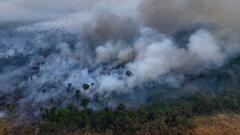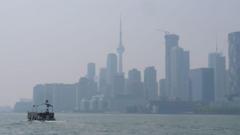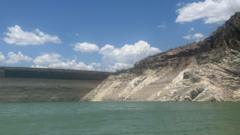A stunning 67,000 square kilometers of tropical forests disappeared last year, primarily due to rampant wildfires, signaling an alarming trend in global rainforest destruction
Tropical Forests Face Unprecedented Destruction Amid Climate Crisis

Tropical Forests Face Unprecedented Destruction Amid Climate Crisis
New satellite data reveals record-breaking loss of tropical forests, raising urgent concerns about climate resilience
The world’s tropical forests, crucial for climate regulation and home to diverse ecosystems, experienced an unprecedented rate of destruction last year, according to a satellite analysis published recently. Researchers estimate that approximately 67,000 square kilometers (26,000 square miles) of these vital forests were lost in 2024, equivalent to an area nearly the size of the Republic of Ireland, with an alarming rate of 18 football fields being lost every minute.
The analysis indicates that wildfires have become the primary factor behind this dramatic loss, surpassing traditional land-clearance for agriculture for the first time. The Amazon rainforest, in particular, suffered gravely due to record drought conditions exacerbated by climate change, further intensified by the natural El Niño phenomenon.
However, there is positive news from Southeast Asia, where government initiatives have successfully curtailed forest loss. These instances highlight the potential for policy-driven conservation outcomes, contrasting sharply with the ongoing deforestation trends noted in regions like Brazil.
Tropical forests play a critical role in sequestering carbon dioxide (CO2), storing vast quantities of greenhouse gases in their soils and tree biomass. The recent record of forest loss poses serious questions about their ability to withstand the impacts of a warming climate. Experts warn that specific areas, including parts of the Amazon, may be approaching a "tipping point," where irreversible ecosystem decline could occur.
Professor Matthew Hansen, co-director of the Global Land Analysis and Discovery (GLAD) laboratory at the University of Maryland, described the situation as "frightening," expressing concerns that if current trends continue, entire swathes of rainforest could transition into savannah-type ecosystems, an event termed "savannization."
A separate study pointed out that the possibility of significant dieback in the Amazon looms if global temperatures rise beyond the critical threshold of 1.5 degrees Celsius. Such catastrophic loss not only threatens the extensive biodiversity within these habitats but could also have severe consequences for the global climate, as the burning of forests contributes massively to greenhouse gas emissions.
In 2023-24, the Amazon experienced its worst recorded drought, attributed to climate change, resulting in conditions conducive to widespread wildfires. Notably, the emissions resulting from the destruction of the world’s primary tropical forests in the past year amounted to around 3.1 billion tonnes of greenhouse gases, roughly equivalent to the emissions produced by the entire European Union.
Conversely, in Southeast Asia, particularly Indonesia, a decrease of 11% in primary forest loss was noted compared to the previous year. This decline can be linked to effective government measures enforcing a "no burning" policy aimed at protecting forested areas. Elizabeth Goldman, co-director of the Global Forest Watch project, emphasized the significance of political will in achieving these conservation successes.
Experts believe that the upcoming UN climate summit COP30, set to take place in the Amazon, will be crucial in advancing global forest protection strategies. One potential approach discussed is to incentivize countries that manage to maintain their tropical forests through financial rewards, addressing the economic disparities that currently favor deforestation over conservation.
As the world grapples with climate change, sustainable policies and community engagement will be critical to reversing the destruction of these vital ecosystems, highlighting the need for ongoing vigilance and action to preserve our planet's remaining tropical forests.
The analysis indicates that wildfires have become the primary factor behind this dramatic loss, surpassing traditional land-clearance for agriculture for the first time. The Amazon rainforest, in particular, suffered gravely due to record drought conditions exacerbated by climate change, further intensified by the natural El Niño phenomenon.
However, there is positive news from Southeast Asia, where government initiatives have successfully curtailed forest loss. These instances highlight the potential for policy-driven conservation outcomes, contrasting sharply with the ongoing deforestation trends noted in regions like Brazil.
Tropical forests play a critical role in sequestering carbon dioxide (CO2), storing vast quantities of greenhouse gases in their soils and tree biomass. The recent record of forest loss poses serious questions about their ability to withstand the impacts of a warming climate. Experts warn that specific areas, including parts of the Amazon, may be approaching a "tipping point," where irreversible ecosystem decline could occur.
Professor Matthew Hansen, co-director of the Global Land Analysis and Discovery (GLAD) laboratory at the University of Maryland, described the situation as "frightening," expressing concerns that if current trends continue, entire swathes of rainforest could transition into savannah-type ecosystems, an event termed "savannization."
A separate study pointed out that the possibility of significant dieback in the Amazon looms if global temperatures rise beyond the critical threshold of 1.5 degrees Celsius. Such catastrophic loss not only threatens the extensive biodiversity within these habitats but could also have severe consequences for the global climate, as the burning of forests contributes massively to greenhouse gas emissions.
In 2023-24, the Amazon experienced its worst recorded drought, attributed to climate change, resulting in conditions conducive to widespread wildfires. Notably, the emissions resulting from the destruction of the world’s primary tropical forests in the past year amounted to around 3.1 billion tonnes of greenhouse gases, roughly equivalent to the emissions produced by the entire European Union.
Conversely, in Southeast Asia, particularly Indonesia, a decrease of 11% in primary forest loss was noted compared to the previous year. This decline can be linked to effective government measures enforcing a "no burning" policy aimed at protecting forested areas. Elizabeth Goldman, co-director of the Global Forest Watch project, emphasized the significance of political will in achieving these conservation successes.
Experts believe that the upcoming UN climate summit COP30, set to take place in the Amazon, will be crucial in advancing global forest protection strategies. One potential approach discussed is to incentivize countries that manage to maintain their tropical forests through financial rewards, addressing the economic disparities that currently favor deforestation over conservation.
As the world grapples with climate change, sustainable policies and community engagement will be critical to reversing the destruction of these vital ecosystems, highlighting the need for ongoing vigilance and action to preserve our planet's remaining tropical forests.





















